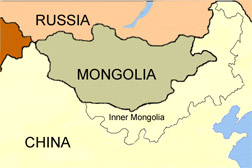This page has been archived and is being provided for reference purposes only. The page is no longer being updated, and therefore, links on the page may be invalid.
|
|
|
|
Asian Grasslands May Hold Global Promise
By Ann PerryDecember 5, 2008
Grazinglands in the Asian steppes and the rangelands in the western United States share similar climates, vegetation, land-use practices and problems. So an Agricultural Research Service (ARS) scientist joined a search in Asia to find and preserve native forage plants—and to see if these plants can be used to sustain and restore arid grasslands in other parts of the world.
ARS plant physiologist Doug Johnson is part of an international collaboration that has been collecting the seeds of rangeland plant species for more than a decade in Mongolia and China’s Inner Mongolia. Pastoral livestock and native herbivores in this region graze year-round on natural pastures of grasses and legumes.
These forages have evolved over thousands of years under sustained grazing pressures, extreme heat and cold, droughts and saline soils. But overgrazing, increased soil erosion and weed infestations now threaten the diversity of this rangeland vegetation.
Johnson works at the ARS Forage and Range Research Laboratory in Logan, Utah. From 1994 to 1998, he and other researchers from Mongolia and China logged approximately 13,000 miles in Mongolia to maximize their search for native forage plant species.
The payoff for their efforts came in the collection of 1,373 plants, including 323 different genera and 581 species. Subsequent field evaluations in Mongolia identified the most promising plants for revegetating abandoned croplands and restoring post-mining landscapes and abandoned urban areas.
In 2006, the collectors also sent 123 collections of seeds from China’s Inner Mongolia to the United States. These seeds are now part of the U.S. National Plant Germplasm System, which contains approximately 509,000 plant accessions from around the world. The Asian seed collections will provide valuable material to U.S. forage breeding programs that are improving forage species and reduced-input turf grasses.
This work will complement Johnson’s previous contributions involving the collection, evaluation, and release of novel and economically important forage cultivars. These forages are widely used by farmers, ranchers and land managers in the semi-arid western United States to increase production efficiency and conserve natural resources.
ARS is a scientific research agency of the U.S. Department of Agriculture.

